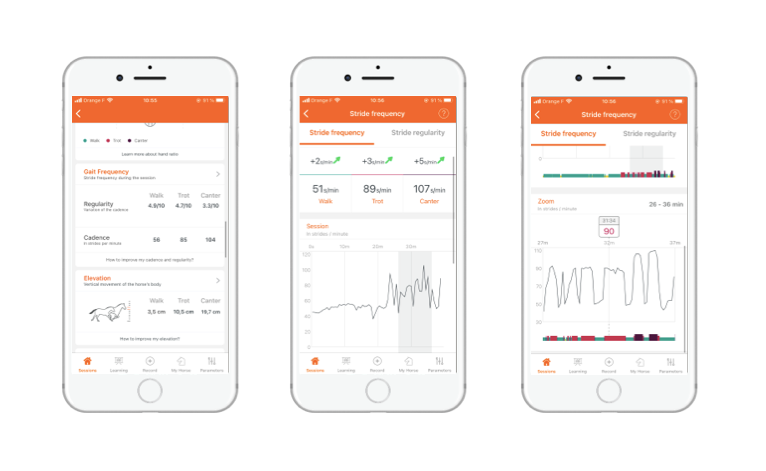All about the Rhythm in the Equisense App
What does cadence mean?
Cadence is the number of strides your horse carries out per minute: a stride is defined as all the events that separate two successive steps of the same limb.
In order to verify the cadence, choose one of your horse’s limbs and count how many times it touches the ground within 1 minute. You will get an idea of the cadence. Otherwise, Motion does it for you and calculates an average rating of the number of steps or strides per minute at each gait.
To give you a general idea of the ranges in value, here are a few for horses during dressage/obstacle sessions:
Walk: 40 - 60 strides / min
Trot: 55 - 90 strides / min
Canter: 80 - 120 strides / min
In practice
When you're alone, you may confuse activity with haste. Remember to watch your rhythm when you are with your coach and try to have the same result when you ride alone.
Also, depending on the work you are doing, such as transitions within the gait for example, cadence regularity can drop if your horse rushes in the extensions and/or slows down too much in the collection. It is therefore a very good indicator to help you improve them. The goal is to get good marks, no matter what the exercise is :)
How do I interpret the graphics of the cadence?
The graphics help you visualizing the improvement of your cadence over time.
Horizontally, you can see the duration of your session. Vertically, you can see the number of strides per minute. The curb shows the overall regularity of the cadence: you can see at what moment your horse changed its cadence, and if there was an increase or decrease. Thus, you can analyze what moment/exercise affected your horse’s cadence… This will give you an idea of what to improve during future sessions.
It is possible that there is only a scatter plot or no curb displayed: like in the example below. It’s simply because you did not spend enougth time in this gait so we are not able to give you a trend.

What is regularity of cadence?
Regularity of cadence is the calculation of the consistency of your horse’s rhythm. Imagine that we set a metronome to beat at the right frequency. Will you and your horse be completely in sync with it for the entire session or not?
This is what we analyze to then give you a rating from 1 to 10. A rating near 10 means that the horse is very consistent in a gait in contrast to a low rating close to 0, which indicates a the horse has an irregular cadence and often changes its rhythm. We don’t take the cadence value itself into account. We look only at its variation. The idea is not to recognize cadence values that are too low or too high but to simply give an indication of “how much did the cadence vary during the session?”.
Most riders try to keep their cadence as steady as possible, especially for dressage. It is not always easy to remain objective. Your Equisense Motion can help you with this.
How is the rating of the regularity of the cadence determined?
We don’t take the value of the cadence itself into account. We look only at its variation. The idea is not to recognize cadence values that are too low or too high but to simply give an indication of “how much did the cadence vary during the session?”.
We calculate the cadence regularity in the same gait for each phase. Let me explain. Imagine an obstacle session during which you carried out a relaxed canter at 85 strides/min with a very regular cadence (8/10), then while working with poles, you cantered at 105 strides/minute with a regularity of 6/10. The old calculation method would have given you a low rating, because the canter went from 85 strides/minute to 105 strides/minute. Now we will give you an average value for each phase, and you will have a regularity of 7/10 (average of 8 and 6/10).
I do not have enough data to calculate my cadence!
Here is an example of not enough data to calculate the cadence of the canter. But what does this mean?
It means that you did not spend enough time cantering to calculate a reliable trend. You need at least 20 seconds in a row in a certain gait to calculate the cadence.

